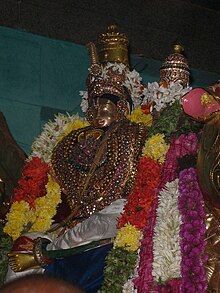Tirumangai Alvar
| Thirumangai Alvar | |
|---|---|

Thirumangai Alvar (left) with his wife Kumudavalli (right, only her crown is visible, rest of her image is covered with garlands)
|
|
| Born | Kaliyan the 8th century CE (traditional dating: 2702 BCE) kuriayalur (thiruvali-thirunagari) |
| Died | Thirukkurungudi (Thirunelveli dist.) |
| Titles/honours | Alvar saint |
| Philosophy | Vaishnava Bhakti |
| Literary works | Periya Tirumoli, Tirunedunthandakam, Tirukuruthandakam, Tiruvelukkutirukkai, Siriya Tirumadal and Periya Tirumadal |
Thirumangai Alvar, also spelt as Tirumangai Alvar and Tirumankai Alvar, or Thirumangai Mannan is the last of the 12 Alvar saints of south India, who are known for their affiliation to Vaishnava tradition of Hinduism. He is considered one of the most learned Alvar and the most superior Alvar in the context of composition of verses. He holds the title Narkavi Perumal, the mark of an excellent poet, and Parakala (Beyond Time).
Though he is respected as a Vaishnava saint-poet, he, initially, worked as a military commander, a chieftain and then a robber. After his conversion to Vaishnavism, he confronted practitioners of rival Hindu sect of Shaivism as well as Buddhism and Jainism.
The traditional date attributed to Thirumangai is year 399 of Kaliyuga, that is 2702 or 2706 BC, making him traditionally the last of the Alvar saints. Modern scholars have placed the Alvars in between 5th to 9th centuries based on few historical evidence. Dr. N. Subba Reddiar summarizes their views and arrives at the date 776 AD for Thirumangai, making him chronologically the eighth Alvar, though even these dates are disputed. Sakkottai Krishnaswami Aiyangar notes he is generally dated to 7th-8th century. Professor of Religion and Asian Studies, James G. Lochtefeld of Carthage College dates Tirumangai to the 9th century.
The hagiographies detailing the life of Thirumangai and other Alvars are Divya charitam (11th century) and Guruparampara-prabhavam-arayirappadi (13th century) and Guruparampara-prabhavam-muvayirappadi (14th century). Other Vaishnava scholars have written hagiographics based on the above works later.
Thirumangai was born in Thirukuraiyalur, a small village in Tamil Nadu, in a non-Brahmin
According to the traditional account, he married Kumudavalli, a Vaishnava doctor's adopted daughter at a place Thiruvellakkulam (also known as Annan Kovil)and became a Vaishnava, devotee of the Hindu god Vishnu, under her influence. The temple-god of Thirunaraiyur (Naraiyur Nindra Nambi) – a form of Vishnu – is believed to have initiated Thirumangai into Vaishnavism, by teaching him the pancha samskara. Kumudavalli also got him to promise that he would feed a 1008 Vaishnavas every day for a year. Unable to bear the heavy expense of feeding a thousand people, Thirumangai resorted to highway robbery. One day, Thirumangai tried to remove rings from the toes of a bridegroom but could not do so. Then he realised the bridegroom was none other than the Supreme god Vishnu himself. Narayana revealed himself to Kaliyan and transformed him by teaching the Narayana mantra or Ashtaksara (the eight syllabled) – "namo narayanaya", turning the robber into a saint and starts singing the first verse of Peria Thirumozhi/ Peria Thirumoli (Vaadinen Vaadi).
...
Wikipedia
